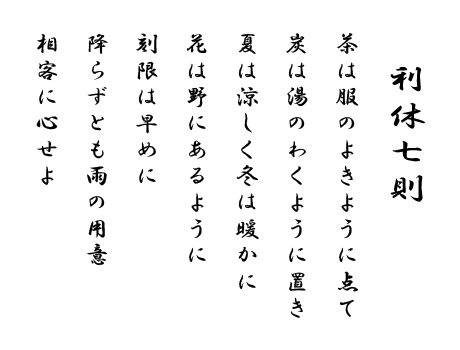| An Introduction to Chado The Spirit of Chado |
 |
|
SEN Rikyu, the 16th-century tea master who perfected the Way of Tea, was once asked to explain what this Way entails. He replied that it was a matter of observing but seven rules: Make a satisfying bowl of tea; Lay the charcoal so that the water boils efficiently; Provide a sense of coolness in the summer and warmth in the winter; Arrange the flowers as though they were in the field; Be ready ahead of time; Be prepared in case it should rain; Act with utmost consideration toward your guests. According to the well-known story relating the dialogue between Rikyu and the questioner mentioned above, the questioner was vexed by Rikyu's reply, saying that those were simple matters that anyone could handle. To this, Rikyu responded that he would become a disciple of the person who could carry them out without fail. This story tells us that the Way of Tea is basically concerned with activities that are a part of everyday life, yet to master these requires great cultivation. In this sense, the Way of Tea is well described as the Art of Living. As seen within Rikyu's seven rules, the Way of Tea concerns the creation of the proper setting for that moment of enjoyment of a perfect bowl of tea. Everything that goes into that serving of tea, even the quality of the air and the space where it is served, becomes a part of its flavor. The perfect tea must therefore capture the 'flavor' of the moment — the spirit of the season, of the occasion, of the time and the place. The event called chaji — that is, a full tea gathering — is where this takes place, and where the Way of Tea unfolds as an exquisite, singular moment in time shared by the participants. |
 |
|
The enduring allure of the Way of Tea is proof of its profound meaning for people — not only Japanese, but
people of all cultures. Having been nurtured on Japanese soil, it represents the quintessence of Japanese
aesthetics and culture. But, over and beyond this, people far and wide have discovered that life is beautified
by this Way — by the spirit that guides its practice, as well as by the objects which express that spirit and
are an integral part of its practice. The principles underlying this Art of Living are Harmony, Respect, Purity, and Tranquility. These are universal principles that, in a world such as ours today, fraught with unrest, friction, self-centeredness, and other such social ailments, can guide us toward the realization of genuine peace. |